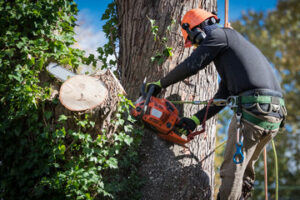Regardless of how large or small your yard is, there are many reasons to get tree services. Trees are important to our natural environment and quality of life; tree service can help you maintain a healthy, beautiful landscape. The benefits of tree service extend well beyond the aesthetics of your yard and include the following:

The cost of tree service can vary greatly depending on several factors. The difficulty of access can increase costs by up to 25 percent. When working near a house, a septic tank, or any soft landscaping, tree service members may need to drag equipment to the tree. Moreover, they might require two workers to do the job, which could add significantly to the bill. While this may not seem a big deal, it can create unnecessary stress and uncertainty.
A professional tree service company will ensure your trees are safe from harm. When a tree is cut down, it can cause many problems. Sprouts can form, taking up space occupied by the parent tree. This can cause barren areas, increase energy costs, and increase heating and cooling bills. Additionally, decay can occur due to saturated soil conditions and a lack of sunlight. It is therefore advisable to contact a company that offers insurance.
Tree services can vary greatly in cost, depending on the size of the tree. Trees less than 30 feet tall typically cost $150 to $500. In contrast, trees between 30 and 60 feet tall can cost between $600 and $1,300. The same applies to trees that are sixty to eighty feet tall. Large trees, such as those more than 80 feet tall, cost anywhere from $1,500 to $3,000.
Depending on the size of the tree and the location, tree removal can cost between $200 and $2,400. Tree removal services can also include stump grinding, which may cost a couple of hundred dollars. But it’s important to consider that amateurs should not handle large trees. Even if you save a few dollars on tree removal, it could result in injuries and hospital bills. This is why professional tree services are the way to go.
The average cost of a tree service varies, but the price range is typically between $75 and $1,500. The range can go much higher or lower depending on the type of tree, the size, and accessibility. For example, a sixty-foot tree can easily cost $1,800 or more, depending on the size and complexity of the job. A multi-trunk tree requires specialized equipment and may have a higher rate.
Certified arborists are qualified professionals with three years of experience and certification in four facets of arboriculture. They can be found in many professions, including landscape architects and construction firms. But what is a certified arborist, and what does it mean? Read on to find out more. Listed below are some of the qualifications of arborists. And make sure you hire one that has these qualifications. They are well-versed in the nuances of tree care, from the best soil conditions to determining the best removal methods.
Certification in urban forestry or tree care is a requirement for some positions, such as those working with pesticides and fertilizers. Additionally, workers must be licensed to use these chemicals, which generally involves passing a test. There are also optional certifications in arboriculture, including the Certified Tree Care Safety Professional (CTCP) program offered by the Tree Care Industry Association and the six certifications offered by the International Society of Arboriculture. Certification in a particular area of arboriculture increases your career opportunities and allows you to work in more complex situations.
ISA certification in arboriculture is the highest level available in the field. There are several ways to earn this credential, but most people earn it by completing a specialized program in the field. To be eligible for certification, an individual must have been an ISA Certified Arborist for three to five years, but their eligibility may depend on additional education and work experience. Certification in arboriculture began as a way to distinguish the top few arborists from the rest of the profession. It also gives others a way to recognize individuals with superior credentials.